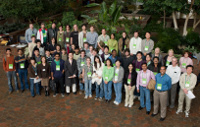 |
 |
|||||||||||||
|
|||||||||||||
|
|||||||||||||
|
In early September 2009, Beijing will serve as host city to roughly 70 outstanding physics students from the Americas, Asia and Europe for a ten-day intensive course entitled the Fourth International Accelerator School for Linear Colliders. The Institute of High-Energy Physics (IHEP) will be the host institution. Led by scientific researchers and academic faculty, the rigorous curriculum will address such topics as linear colliders, the muon collider, radiofrequency technology and damping rings. It will be yet another step forward in the tenure of the school which took place at such locations as Hayama, Japan, Erice, Sicily, Italy, and Oakbrook, Illinois, U.S.A., in previous years. This "melting pot" will offer an international setting and will allow students to become familiar with global efforts in high-energy physics, the international research involved, and to cultivate relationships with their peers. “The students should learn as much as they can and make as many new friends as they can,” said Weiren Chou, Senior Scientist in the Accelerator Division at Fermilab, “since this is a rare opportunity for them to meet a group of talented students who pursue the same goals in life.” The decision to host this school in China did not happen as a coincidence, nor overnight, but rather after significant reflection on Chinese efforts in high-energy physics and its role in the linear collider field. As an example, the country now has a circular collider named BEPC-II which just reached a luminosity of 3 x 1032 cm-2s-1 and it has come to develop very advanced technology in lepton colliders. “The Chinese are very ambitious to get to the frontier of particle physics and linear colliders, and they have a good R&D program for superconducting radiofrequency technology,” said Chou. The Chinese government cooperates with the school to reinforce interest in high-energy physics research. The school's financial support comes from such agencies as the Chinese Academy of Science (CAS), National Natural Science Foundation of China (NSFC), and the China Center of Advanced Science and Technology (CCAST). Scientists agree that the future of high-energy physics is the lepton colliders, a field where China is actively participating. To reflect these contemporary scientific trends, the first two mandatory attendance days of the school led by Barry Barish (ILC-GDE Director), Frank Tecker (CERN) and Bob Palmer (Brookhaven National Laboratory) will discuss such subjects as the ILC, CLIC and the muon collider. Given the changing nature of high-energy physics, the committee has decided this year to allow students to choose one of the two offered course of studies. “The students will broaden their horizon thanks to the many topics covered,” said Stefan Simrock, head of beam controls at DESY, “at the same time, they will get a better understanding of the big picture.” One option is called accelerator physics where students will learn about electron and positron sources, damping rings, linear accelerators and beam delivery system technologies. These will be taught by professors from the universities of Liverpool and Hiroshima and leading research scientists at CERN and CEA. “Accelerator physics covers a large area of physics and technology which cannot be found in other disciplines,” said Simrock, “and we will try to supply a broad background to the topic through these courses. The school's emphasis on accelerator physics come at a particular time in history where, rooted in both linear and circular accelerator physics, it has served as the basics for studying lepton colliders and it is thus important to study all the fundamentals involved for students to develop related research work and interest.” The second option is called radiofrequency (rf) technology where all rf-associated topics will be addressed and students will learn about warm (room temperature) and cold (superconducting) rf technologies, low-level and high-level rf systems, respectively. “Radiofrequency has been always considered as some exotic field,” said Simrock, “the structure of the rf course for high-power sources will be focused on basic theories followed by technologies of klystrons and modulators.” High-power rf system have often served as the basis for radar systems, radio stations, and accelerators and require an rf/microwave engineering background while low-level rf (LLRF) is now going digital so that signal processing and control theory skills are required. All interested graduate students, post-doctoral fellows, and junior research specialists should now apply for the Fourth International Accelerator School. Students should demonstrate commitment, exceptional research abilities and interest in high-energy physics to become eligible candidates. All applications will be judged based on the nature of the submitted curriculum vitae and letters of reference. The deadline for registration is 5 June, after which the academic committee will select the best students for this programme. All admitted students will receive financial aid for attending the school. “For young scientists interested in working on future colliders, this school is the best opportunity to become academically prepared in high-energy physics,” said Chou. -- Andre Sulluchuco |
|||||||||||||
| © International Linear Collider |
